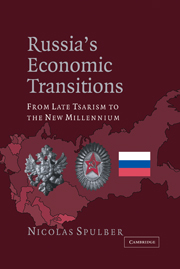Book contents
- Frontmatter
- Contents
- Figures and Tables
- Preface
- PART I THE TSARIST ECONOMIC TRANSITION
- PART II THE SOVIET ECONOMIC TRANSITION
- PART III THE POST-SOVIET ECONOMIC TRANSITION
- 19 The Socioeconomic Framework
- 20 The Transition Issues
- 21 The Economic Policies
- 22 The Problems of Agriculture
- 23 The Industrial Changes
- 24 Domestic and Foreign Trade
- 25 Money and Banking
- 26 State Finance
- 27 Overall View
- Index
24 - Domestic and Foreign Trade
Published online by Cambridge University Press: 03 December 2009
- Frontmatter
- Contents
- Figures and Tables
- Preface
- PART I THE TSARIST ECONOMIC TRANSITION
- PART II THE SOVIET ECONOMIC TRANSITION
- PART III THE POST-SOVIET ECONOMIC TRANSITION
- 19 The Socioeconomic Framework
- 20 The Transition Issues
- 21 The Economic Policies
- 22 The Problems of Agriculture
- 23 The Industrial Changes
- 24 Domestic and Foreign Trade
- 25 Money and Banking
- 26 State Finance
- 27 Overall View
- Index
Summary
The Domestic Trade Network
Post-Soviet Russia has provided the population with consumer goods and services through an expanding network of retail stores, public catering establishments, wholesale trading organizations, and a number of household service institutions involved in information, health, dwellings, culture and science, credit and finance, and so on. What is the pattern of ownership in this sector? How many trading enterprises and workers are engaged in this field? What exactly is the commodity composition of this trade? What is the structure of the households' and of the companies' expenditures in domestic trade? These are the main questions that I consider in this chapter.
As I pointed out previously (in Chapter 21), the privatization drive affected between 1992 and 1998 a total of 43,166 retail stores, 9,922 public catering enterprises, and, from 1993 to 1998, 1,517 wholesale trade establishments. During this period, the ownership shares in retail trade turnover changed as indicated in Table 24-1. The share of the state fell from 41 to 7 percent while that of the private sector increased from 52 to 80 percent and that of mixed enterprises from 7 to 13 percent. However, the state still holds blocks of stocks in the large private companies as well as in the mixed ones.
Over the period 1993 to 1998, the number of retail and public catering stores increased appreciably, but the number of their workers decreased sharply.
- Type
- Chapter
- Information
- Russia's Economic TransitionsFrom Late Tsarism to the New Millennium, pp. 353 - 362Publisher: Cambridge University PressPrint publication year: 2003



